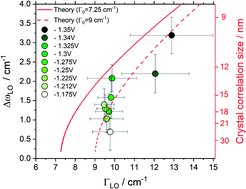Grain size control of crystalline III–V semiconductors at ambient conditions using electrochemically mediated growth†
Abstract
The III–V semiconductor family has composition and size dependent optoelectronic properties ideal for a variety of applications in photonics and electronics. Due to the ever-increasing demand for nanophotonic and nanoelectronic devices, new crystal growth techniques have been proposed to tackle economical disadvantages of the more traditional methods. Electrochemical mediated III–V crystal growth has been demonstrated at room temperature and pressure. One of the advantages of this technique is the possibility of controlling the crystal growth with the applied potential. In this work we study the relationship between the applied potential and the resulting crystal structure of InAs. Raman analysis shows that the average crystal correlation length of the electrochemically grown InAs can be tuned by the deposition potential. In particular, we find that the average crystal correlation length decreases with applied potential, following the phonon confinement model. The decrease in the average crystal correlation length is explained here by an increase in the nanostructured roughness of the grown InAs. Such roughness is likely induced by co-contaminant gas evolution (e.g., H2 and AsH3). Our results clearly show that the crystal grain size of electrochemically-mediated growth of III–V semiconductors can be controlled with the potential, opening up the possibility to fine-tune optoelectronic properties at ambient conditions.



 Please wait while we load your content...
Please wait while we load your content...